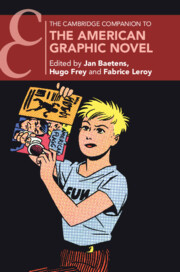Book contents
- The Cambridge Companion to the American Graphic Novel
- The Cambridge Companion to the American Graphic Novel
- Copyright page
- Contents
- Figures
- Contributors
- Editors’ Acknowledgments
- Introduction
- Part I History and Genre
- 1 The “First” Graphic Novel in America
- 2 The Mad-Men Generation
- 3 From Justin Green and Art Spiegelman to Alison Bechdel
- 4 Graphic Journalism
- 5 “Great” American Graphic Novels
- 6 Crime
- 7 Superheroes in Graphic Novels
- 8 Science Fiction and Fantasy
- 9 “Scared Witless”
- Part II Graphic Novels and the Quest for an American Diversity
- Index
- Cambridge Companions To …
- References
6 - Crime
From EC Comics to Ed Brubaker
from Part I - History and Genre
Published online by Cambridge University Press: 10 January 2024
- The Cambridge Companion to the American Graphic Novel
- The Cambridge Companion to the American Graphic Novel
- Copyright page
- Contents
- Figures
- Contributors
- Editors’ Acknowledgments
- Introduction
- Part I History and Genre
- 1 The “First” Graphic Novel in America
- 2 The Mad-Men Generation
- 3 From Justin Green and Art Spiegelman to Alison Bechdel
- 4 Graphic Journalism
- 5 “Great” American Graphic Novels
- 6 Crime
- 7 Superheroes in Graphic Novels
- 8 Science Fiction and Fantasy
- 9 “Scared Witless”
- Part II Graphic Novels and the Quest for an American Diversity
- Index
- Cambridge Companions To …
- References
Summary
This chapter focuses on a specific comics genre, crime fiction, and the multiple relationships between the two spheres of comics and graphic novels. It takes as its starting point the Crime Does Not Pay magazine (1942), while also presenting a detailed overview and critical analysis of the history of crime comics, which in the beginning often purported to be based on true crime stories. The chapter further analyzes the policy of EC Comics, which entered the crime fiction trend in 1948 before transitioning to horror and science fiction. The chapter then examines the appearance of a new orientation within the EC stories, aiming at effecting progressive social change, in sharp contrast to the severe criticism voiced by psychologist Fredric Wertham, whose anti-comics crusade resulted in the Comics Code (1954). After its implementation, crime fiction disappeared from mainstream comics, but reappeared in the independent comics boom, where creators continued to mine the subversive potential of the genre for political commentary. A close reading of Ed Brubaker’s oeuvre illustrates the new forms of the crime comics tradition today.
- Type
- Chapter
- Information
- The Cambridge Companion to the American Graphic Novel , pp. 106 - 121Publisher: Cambridge University PressPrint publication year: 2023
References
- 1
- Cited by

